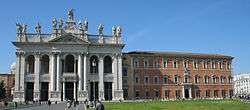Lateran



Lateran and Laterano are the shared names of several architectural projects throughout Rome. The properties were once owned by the Lateranus family of the former Roman Empire. The Laterani lost their properties to Emperor Constantine who in turn gave it to the Catholic Church in 311.
The most famous Lateran buildings are the Lateran Palace, once called the Palace of the Popes, and the Basilica of St. John Lateran, the cathedral of Rome, which although part of Italy is a property of the Holy See that has extraterritorial privileges as a result of the 1929 Lateran Treaty. As the official ecclesiastical seat of the Pope, St. John Lateran holds the Papal cathedra in its apse. The Lateran is Christendom's earliest basilica.
Attached to the basilica is the Lateran Baptistery, one of the oldest in Christendom. Other constituent parts of the Lateran complex are the building of the Scala Sancta with the Sancta Sanctorum and the Triclinium of Pope Leo III.
The Pontifical Lateran University, or simply Lateranum, is one of the pontifical universities of Rome. The former Lateran Museum ceased to exist in 1970, when Pope John XXIII moved the collections to the Vatican Museum.[1] An ecclesiastical college in the Philippines was named after the Basilica of St. John Lateran, the Colegio de San Juan de Letran, founded in 1620.
References
- ↑ "Vatican Museums". Office of the President, Vatican City State. Retrieved 2009-09-29.
External links
| Wikimedia Commons has media related to Lateran. |
- Scala Sancta (Holy Stairs) - Article from the Catholic Encyclopedia
- Christian Museum of Lateran - Article from the Catholic Encyclopedia
- Colegio de San Juan de Letran#History